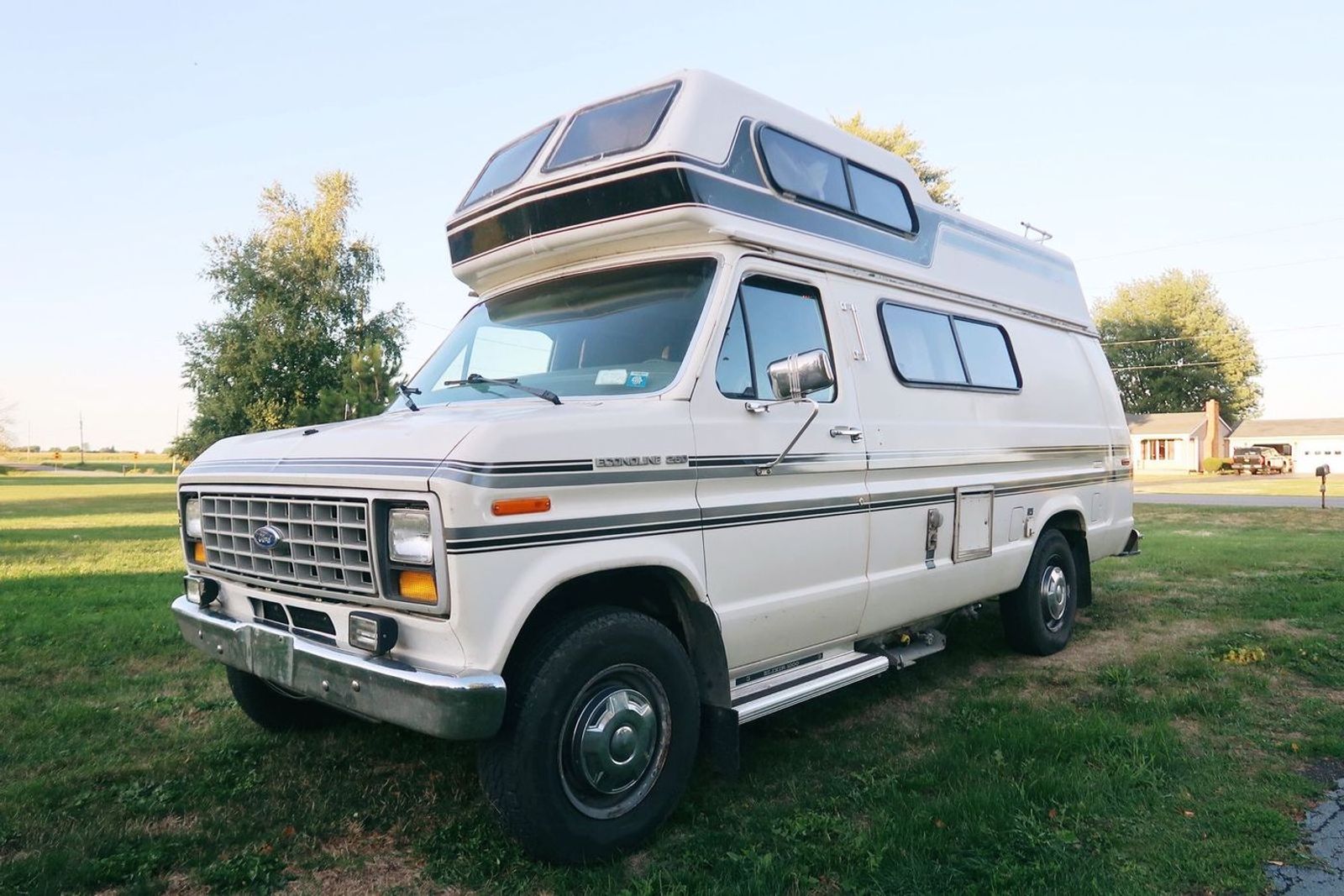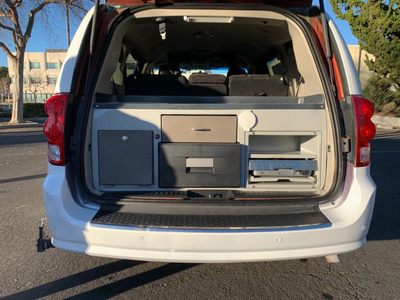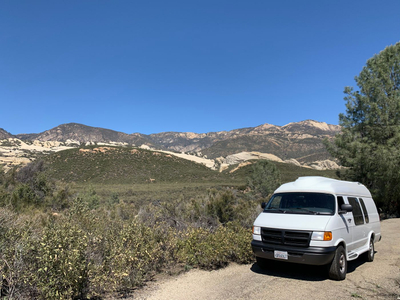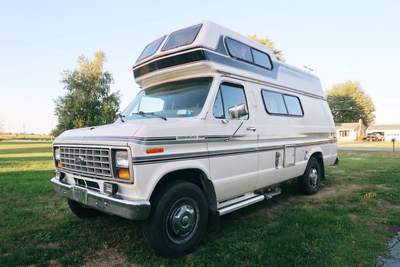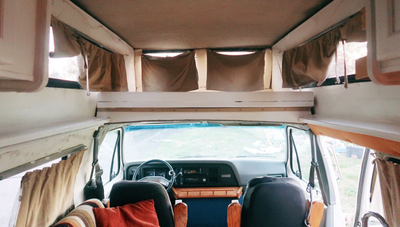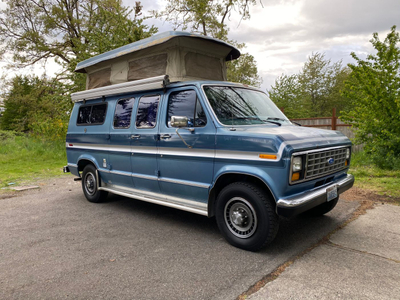If you're looking to buy a campervan, or build out your own, you maybe asking yourself: "should I go with a normal size roof or something I can stand up in?"
It's a fairly common question and the answer really depends on a) your budget and b) what you intend to use your campervan for. In this article we're going to cover the most common types and sizes of roofs found in campervans and go over the pros/cons of each - including what roofs work best for different types of vanlife!
The 3 types of roof found in most campervans
Generally speaking, there are 3 types of roofs found in most campervans:
- low roofs (aka standard size roofs)
- hi-tops (also includes "medium" height roofs)
- pop-up roofs (aka pop-tops)
Low roof
Low roof cargo vans and minivans are widely available used and make for great budget campervan builds. Since space is tight and you can't stand up inside them, many builds place the kitchenettes in the rear of the van, where cooking is done standing outside.
The most common vans with standard size roofs used for van builds are cargo vans and minivans, with popular models including the Ford Econoline, Chevrolet Express, Chevrolet Astro, Dodge Caravan and Toyota Sienna. More modern options include the Ford Transit, Ford Transit Connect, Ram Promaster (City and Cargo Low Roof) and Mercedes Metris.
Pros:
- Cheapest option.
- Lots of them can be found used.
- Easiest to drive and park (they fit everywhere a car does).
- More aerodynamic/better fuel economy.
- Easier to drive in poor conditions (such as heavy winds).
- No clearance issues for drive-thrus or parking lots.
- Smaller space and therefore quicker to convert.
Cons:
- You can't stand up in them!
- Cooking inside the van can be a pain - most low roof campervans have the kitchen fitted at the rear of the van for this reason.
- Since cooking is often done outside, they are not so practical for cold or wet weather environments.
- Getting changed or cleaning yourself can be more awkward.
- It can feel less "homey" and cramped if you are two or more.
- Less storage space (since most hi-top campervans make use of the extra height to fit cabinets).
- Since they are smaller, there's less room for a sink, extra storage or a dedicated working area, though it's definitely possible with a bit of creativity.
What they work best for:
- Shorter trips where you're not living in the van.
- People who don't mind doing more activities outside of the van (such as cooking and washing up).
- People on a budget.
- Solo warriors.
- Shorter people!
What they are not so good for:
- Full time van living - it's perfectly possible, just not as comfortable at times.
- People with any physical discomforts which are going to be made worse by being crouched over all the time.
- Tall people - the taller you are, the more awkward it gets.
Hi-tops
Hi-top vans typically contain enough vertical space to walk around in without crouching or hitting your head, though depending on how tall you are, this can vary. Broadly speaking, there are three different types of hi-roofs commonly found in campervans:
- Factory high roofs - most modern vans like Sprinters, Promasters and Ford Transits come with various high roof options straight from the factory.
Modern vans like the Ford Transit 250 come from the factory with high roof configurations. This makes cooking inside the van much easier - as well as providing much more space for cabinets, shelves and even additional sleeping areas.
- "Turtle top" or "bubble top" roofs. Mostly found in older conversion vans from the 1980s/1990s, these vans have had the original roof cut away and replaced with a fibreglass roof to increase the van's height. Whilst bubble top roofs are a definite upgrade from a standard roof, they are not tall enough for some people to fully stand up in. If you're looking to buy one used, check with the seller to see what the standing height is.
Older conversion vans, like this 1999 Dodge Ram Van B3500, come with "bubble top" roofs which increase the height of the van. These are generally cheaper than modern vans but depending on your height you may not be able to fully stand up in them.
- Standing height fibreglass roofs with cabovers. Many manufactured Class B campervans from the 1990s are equipped with fibre glass roofs that are tall enough to fully stand up in. These are distinguishable from "bubble tops" since they are much higher and many contain a cabover sleeping area.
Manufactured campervans from the 1980s/1990s, like this remodelled Coachmen 1987 Ford E250, contain standing height fibre glass roofs, many of which with cabovers - an overhang area above the driver's seat which provides an additional sleeping area or extra storage.
Pros:
- The obvious - being able to stand up in the van just makes a lot of things easier, especially cooking.
- The increased height of the van can be used to accommodate extra cabinets, shelves and storage space.
- Many vans with fibre glass roofs from the 1980s/1990s have cabovers - an overhang area above the driver's seat which accommodates an extra bed (or additional storage).
- Physically easier on the body - less awkward having to crouch all the time.
Cons:
- High roof vans are typically more expensive.
- Many don't fit in standard size garages or carports.
- Less aerodynamic, especially in high wind areas.
- Poorer fuel economy compared to standard size vans.
- Clearance can become an issue when going through some drive-thrus or parking garages, especially if you have solar panels or roof fans.
What they work best for:
- Full time van living. Common tasks like cooking, washing up, getting changed and so forth are just much easier when you can stand up freely and walk around. Since you can do this all inside the van, they are better for wet or cold environments.
- People who need to sleep more than two people. With the right floor-plan, hi-top vans can accommodate two beds.
- People who need to store a lot of gear - the extra height allows for a lot more cabinet/storage space.
- Tall people - or anyone that would have a hard time crouched over all the time.
What they are not so good for:
- People on a shoe-string budget - hi-top vans are more expensive to buy.
- People who want to store their van in a garage or carport (or other constraints related to the height of the van).
Pop-up roofs
This 1991 Ford E-250 Sportsmobile Campervan comes equipped with a pop-up roof. Whilst camping, the roof is raised to provide extra height for standing - and closed again when driving. The pop-up roof also provides an additional sleeping area (great for kids), which can also just be used for additional storage space.
Pop-up roofs aka pop-tops give you the best of both worlds. Whilst driving or storing the van, the roof can be lowered, reducing the height of the van to a standard size. When you're ready to camp, you simply "pop-up" the roof, giving you the extra standing height when needed!
Pop-up roofs are most commonly found on manufactured campervans, such as Westfalia VW Vanagon conversions, VW Eurovans, GTRV and Sportsmobile conversions. You'll also find them on newer class B RVs such as the Pleasure Way Tofino or Hymer Activ Dodge Promaster. There are a handful of companies which specialize in adding a pop-up roof to your van, though the conversion isn't cheap.
Pros:
- You get the best of both worlds - they fit in any parking spot and are easier to drive, and when needed, pop-up to give you extra standing height.
- The pop-up roof can be used for extra sleeping or storage, though in our experience, it's best for kids or shorter adults.
- Whilst camping, the pop-up roof allows for extra air to flow through the van whilst also keeping bugs out. Great for those hotter days!
Cons:
- Expensive! Campervans with pop-up roofs are much more expensive to buy, because the conversion itself is costly.
- The canvas of the pop-up roof is prone to tears and leaking if not properly maintained.
- It adds a little extra time to setting up (and packing up) camp.
What they work best for:
- People who want all the perks of a hi-top van but need to be able to store their van in a standard size garage or carport.
- People who want an additional sleeping area for kids or shorter adults.
What they are not so good for:
- People who want solar panels in their build - it's possible but the installation is more complicated than a standard roof.
- People on a budget - pop-ups are expensive, and if you don't have parking constraints, it's cheaper to go with a hi-top van.
What type of campervan roof is right for me?
Most of this comes down to budget and what you intend to use your campervan for. For full-time van dwelling, if you can afford it, we recommend going with a hi-top van. The extra height and storage space makes living in the van way more comfortable. If you can't afford a modern hi-top van, older conversion vans with turtle top roofs or 1980s/1990s Class B Campervans with hi-top fibre glass roofs are also good options. Depending on how tall you are, some turtle top vans aren't quite standing height, but they're still more comfortable than a standard size roof.
If you're a solo warrior, trying to do things on a tight budget, or you're just using your van for weekend trips or don't mind doing stuff like cooking outside, a standard size roof is also a great option. They are much cheaper, easier to drive and can be found used almost everywhere.
Pop-up roofs are the ultimate camping luxury and for the most part give you the best of both worlds. They make great options for families with kids or people who want to store their van in a standard size garage or carport. However, if you don't need to store your van in a garage/carport, hi-top vans are much better value for money.
This article was produced by the Vancamper team and may not be copied, redistributed or modified without our permission.
